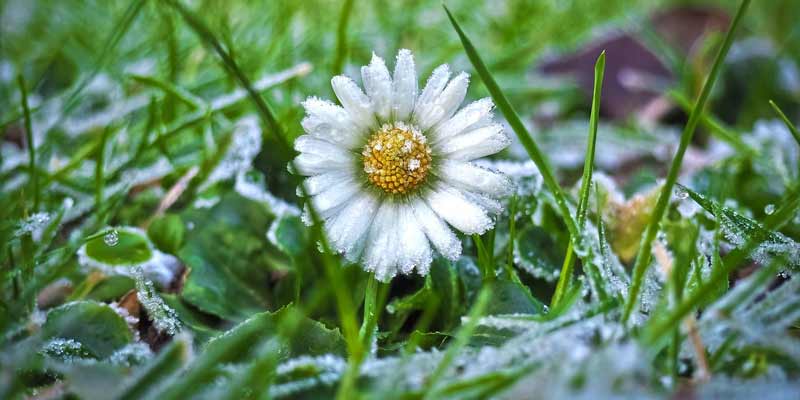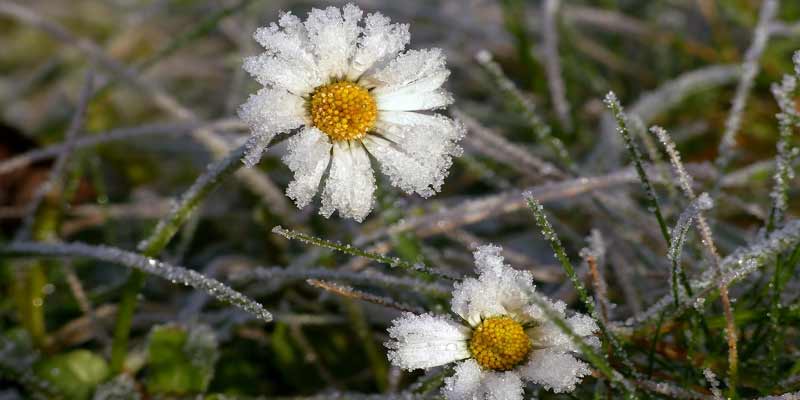The delicate petals and vibrant hues of daisies evoke images of summer meadows and sunny days. However, despite their seeming resilience, these charming flowers confront a significant challenge when temperatures plummet; it is none other than frost that presents itself as an icy veil of winter posing threats not just to daisies but many other plants. Can these resilient blooms endure the frost’s chill?
This article delves into daisies’ biology, explores frost’s effects on them, and examines the strategies they implement to survive in harsh conditions.
Understanding Daisies
Scientifically known as Bellis perennis, daisies belong to the Asteraceae family; they originate from Europe and Asia. Their simple, yet captivating appearance features a bright yellow center encircled by delicate white petals: an iconic image indeed. Thriving typically in temperate climates, daisies prefer two environmental factors—well-drained soil and ample sunlight.
Perennial plants, such as daisies, can endure for multiple years under optimal conditions. Daisies propagate through seeds and also have the capacity to multiply via division. Their popularity as additions in gardens and landscapes across the globe stems from their remarkable adaptability and resilience to a variety of environments.
The Impact of Frost
When temperatures plummet below the freezing point, moisture in the air crystallizes and forms ice on surfaces – this is what we call frost. Frost poses a significant challenge for plants such as daisies as it can damage plant cells through ice crystal formation, disrupt vital processes, and even induce tissue injury.
Frost settling on daisies induces cellular dehydration, damages cell walls, and ultimately impairs the plant’s effective functionality. The extent of this frost damage relies upon various factors: exposure duration; cold intensity; and physiological state of the plant.
Strategies for Survival
Frost poses a significant threat; however, daisies have evolved multiple mechanisms, which all boost their survival rates.
Cold Acclimation
Like numerous plants that tolerate cold temperatures, daisies actively undergo the process of cold acclimation. Gradually decreasing temperatures during this period provoke physiological changes within the plant through exposure. Certain compounds, such as sugars and proteins, accumulate to act as cryoprotectants. They safeguard delicate cellular structures from damage through this process.
Insulation
The compact growth habit of daisies; their dense foliage acting as layers, provides a degree of insulation against frost. Heat radiating from the ground is trapped by these leaves, thus creating a microclimate that registers slightly warmer than its surrounding environment. This microclimate can offer some protection to the plant during periods of frost.
Root Protection
Frost may indeed damage the aerial parts of daisies; however, the roots—susceptible as they are to this threat—often remain insulated beneath the soil. The soil functions brilliantly as a natural buffer against drastic temperature changes; it effectively safeguards and shields these roots from potential frost damage.
Regenerative Capacity
Remarkable regenerative capacity characterizes daisies; under favorable conditions, they can recover from even frost damage. With rising temperatures and improved growing conditions, these resilient plants initiate new growth, which is a process that replenishes any lost or damaged foliage by sprouting fresh leaves out of their dormant buds and meristematic tissues.
Genetic Variation
Genetic variation within daisy populations crucially determines the plant’s ability to withstand frost. Some individuals may exhibit traits such as producing antifreeze proteins or adjusting their metabolic processes in response to low temperatures that confer a higher cold tolerance.
The Role of Gardeners
Daisies inherently possess mechanisms to cope with frost, yet gardeners can enhance their resilience as well. Consider these tips to protect your daisies from potential damage caused by frost:
Mulching
The process of mulching involves the application of a layer specifically, organic mulch around daisies. This method not only insulates and regulates soil temperature fluctuations; it also minimizes exposure to freezing temperatures by acting as a protective barrier that reduces heat loss from the ground.
Covering
During periods of anticipated frost, if we cover daisies with lightweight fabric or garden cloches; this action can offer temporary protection against the cold. These covers serve to trap heat, a significant preventive measure by avoiding direct contact between plants and settling frost.
Watering
Watering daisies before an anticipated frost mitigates damage: it bolsters soil moisture and diminishes the risk of desiccation. Moist soil with its superior heat retention compared to dry earth fosters a more hospitable environment for plant roots.
Pruning
Before winter sets in, removing dead or damaged foliage promotes airflow and mitigates the risk of fungal infections; it also enhances the plant’s efficiency in allocating resources for healthy growth.
Conclusion
The intrinsic beauty and resilience of daisies captivate gardeners and nature enthusiasts across generations. Despite the formidable challenge that frost presents to these delicate blooms, they endure and thrive in adversity through their adaptive mechanisms, a feat facilitated by diligent gardeners’ stewardship.
The tenacity of daisies and other cold-tolerant plants dazzles us, reminding us not only of nature’s resilience but also of the intricate balance within life. By comprehending this delicate equilibrium and acting as stewards, we have an opportunity to nurture these botanical treasures for future generations; thereby securing a future where daisies continue brightening our gardens and landscapes—even during winter’s chilliest grasp.



Leave a Reply